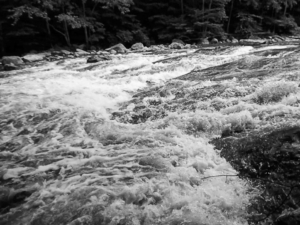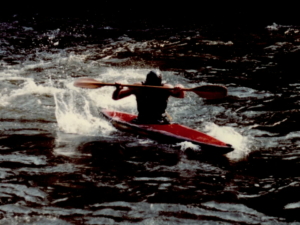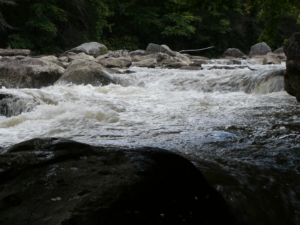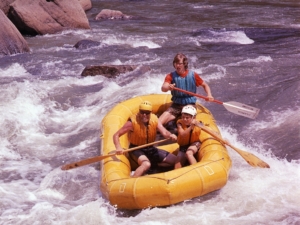 http://historyoftheupperyough.com/wp-content/uploads/2021/02/Wrights-Wide-e1612409907739.jpeg
718
959
chrispreperato
http://historyoftheupperyough.com/wp-content/uploads/2014/04/logo1.png
chrispreperato2021-02-04 03:20:142021-02-05 22:40:47Wright’s Hole
http://historyoftheupperyough.com/wp-content/uploads/2021/02/Wrights-Wide-e1612409907739.jpeg
718
959
chrispreperato
http://historyoftheupperyough.com/wp-content/uploads/2014/04/logo1.png
chrispreperato2021-02-04 03:20:142021-02-05 22:40:47Wright’s Hole“The shooting has stopped at Sang Run.”
That opening sentence, lying beneath an equally benign headline of “Upper Yough,” fills only a small corner of a page in the American Whitewater Journal. Tucked away between articles on finding paddle buddies and President Reagan trying to gut the Wild and Scenic Rivers Act, it was announcing a fundamental shift in the way forward for boaters in the Youghiogheny Valley, and yet a reader could have missed it entirely. Why wasn’t this article the front page of the magazine? And how had things gotten so bad at Sang Run; boaters so used to being harassed and shot at, that it was the stuff of tiny articles and benign headlines?
It would be easy to blame the Maryland State Legislature for the problem. In 1976, they declared the Youghiogheny to be a state Wild and Scenic River, effectively rezoning the river from Oakland to Friendsville, and placing tight restrictions on how the land could be used. The residents of Garrett County, already not particularly fond of the politicians in Annapolis, were furious. The word “communist” became commonplace among the residents, and they organized a network of communication to keep out-of-towners from enjoying the area. For boaters, this meant angry, and often armed, confrontations at the bridge in Sang Run. The boaters hadn’t created the law, and though many were supportive of it, they were taking the brunt of the response. Yes, blaming the politicians would be easy, but it would also miss the larger context for the law, and why, at that time, in that place, it was the only way to save the river.

Dead rivers surrounded the Youghiogheny
West of the Youghiogheny, the Cheat River was an orange mess. To the north, the Monongahela was likewise troubled by pollution. Even worse, to the east, the North Branch of the Potomac was so riddled with acid mine drainage that boaters avoided it when possible. For each river, hundreds of mines were the source of the problem. And not just active mines. Often, the culprit was an abandoned mine that had been improperly sealed, or worse, never sealed in the first place. Resource harvesters had run roughshod over the area for the better part of the century, and finally, at the start of the 1970’s, regulators were pushing back.
The first push was to make the Youghiogheny a national Wild and Scenic river, but that effort was defeated in the early phases. The next move was a restriction on coal mining and lumber harvesting, but portions of that were struck down in the Maryland courts. With major mines ready to open, the Maryland Department of Natural Resources decided to act. It declared the Yough a “wild” river from Miller’s Crossing through Friendsville. The designation meant that land could not be sub-divided, that no new roads or buildings could be built within the corridor, and that anything within sight of the river had the match the natural aesthetic. The joke in Sang Run was that you now needed a permit just to paint your shed. Locals were angry that a state agency seemed to be taking over their land, land they saw profit in from coal and timber companies, and they weren’t being compensated for the change.
While boaters took most of the immediate abuse, the landowners and coal companies combined to fight the new laws in court. They also lobbied their politicians and organized campaigns to unseat the legislators who had crafted the law. Edward Mason had been a state senator for over a decade, but his support of the wild and scenic legislation led to a narrow victory in the 1978 election, and his eventual ouster in the 1982 elections. His replacement, John Bambacus, ran on a platform of returning the land to private ownership.
While boaters were no longer being shot at by 1982, the issue was far from decided. Like the arrangement the boaters had made to access the river, politicians too had to create a series of agreements to cement the Yough’s legacy. Other public land was swapped for Yough land and restrictions were loosened for issues like sub-dividing land. What remains to this day is a sort of detente. Even the most hardened of locals can see the benefits of preserving the valley, politicians see the value in calm rather than chaos, and boaters can appreciate that they are just visitors in an area where some families have lived for centuries.
See More Upper Yough History
 http://historyoftheupperyough.com/wp-content/uploads/2021/02/Wrights-Wide-e1612409907739.jpeg
718
959
chrispreperato
http://historyoftheupperyough.com/wp-content/uploads/2014/04/logo1.png
chrispreperato2021-02-04 03:20:142021-02-05 22:40:47Wright’s Hole
http://historyoftheupperyough.com/wp-content/uploads/2021/02/Wrights-Wide-e1612409907739.jpeg
718
959
chrispreperato
http://historyoftheupperyough.com/wp-content/uploads/2014/04/logo1.png
chrispreperato2021-02-04 03:20:142021-02-05 22:40:47Wright’s Hole
Meatcleaver

The Upper Yough Race

Bastard Falls
 http://historyoftheupperyough.com/wp-content/uploads/2021/02/Kendall-Lumber-company-@-Kendall-scaled-1.jpg
750
1000
chrispreperato
http://historyoftheupperyough.com/wp-content/uploads/2014/04/logo1.png
chrispreperato2021-02-05 03:57:132021-02-06 02:02:07The Little Town In The Woods
http://historyoftheupperyough.com/wp-content/uploads/2021/02/Kendall-Lumber-company-@-Kendall-scaled-1.jpg
750
1000
chrispreperato
http://historyoftheupperyough.com/wp-content/uploads/2014/04/logo1.png
chrispreperato2021-02-05 03:57:132021-02-06 02:02:07The Little Town In The Woods http://historyoftheupperyough.com/wp-content/uploads/2017/11/73-21-copy-e1612397228859.jpg
863
1149
chrispreperato
http://historyoftheupperyough.com/wp-content/uploads/2014/04/logo1.png
chrispreperato2021-02-03 04:20:362021-02-05 22:43:23The Guides
http://historyoftheupperyough.com/wp-content/uploads/2017/11/73-21-copy-e1612397228859.jpg
863
1149
chrispreperato
http://historyoftheupperyough.com/wp-content/uploads/2014/04/logo1.png
chrispreperato2021-02-03 04:20:362021-02-05 22:43:23The Guides

